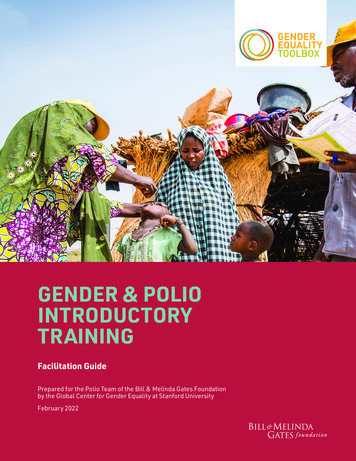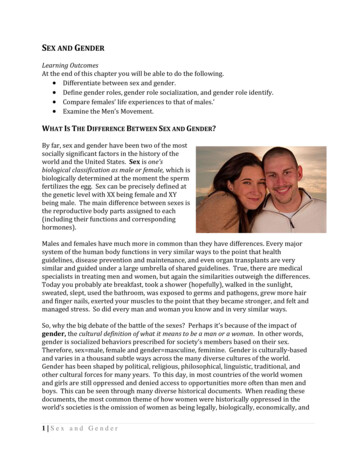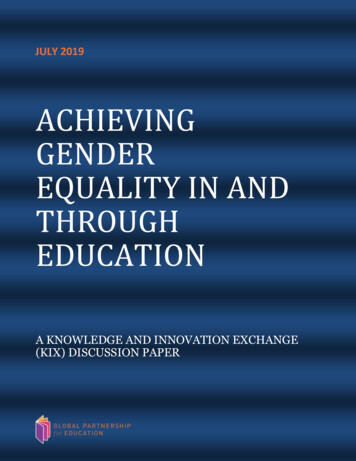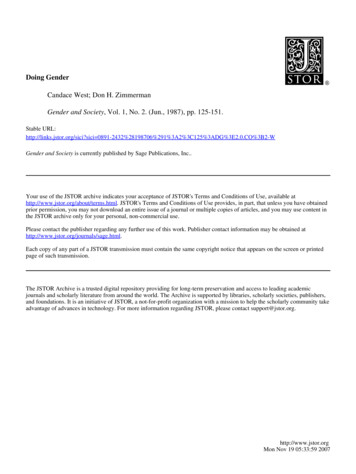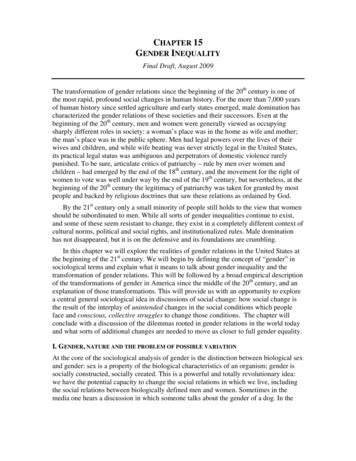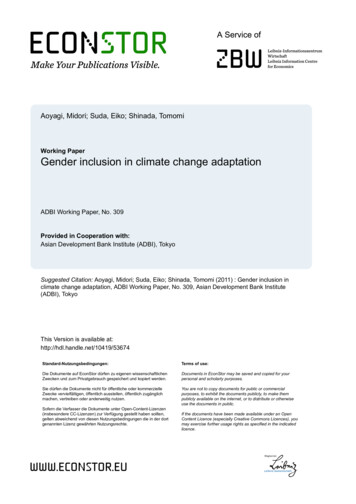
Transcription
Aoyagi, Midori; Suda, Eiko; Shinada, TomomiWorking PaperGender inclusion in climate change adaptationADBI Working Paper, No. 309Provided in Cooperation with:Asian Development Bank Institute (ADBI), TokyoSuggested Citation: Aoyagi, Midori; Suda, Eiko; Shinada, Tomomi (2011) : Gender inclusion inclimate change adaptation, ADBI Working Paper, No. 309, Asian Development Bank Institute(ADBI), TokyoThis Version is available ngsbedingungen:Terms of use:Die Dokumente auf EconStor dürfen zu eigenen wissenschaftlichenZwecken und zum Privatgebrauch gespeichert und kopiert werden.Documents in EconStor may be saved and copied for yourpersonal and scholarly purposes.Sie dürfen die Dokumente nicht für öffentliche oder kommerzielleZwecke vervielfältigen, öffentlich ausstellen, öffentlich zugänglichmachen, vertreiben oder anderweitig nutzen.You are not to copy documents for public or commercialpurposes, to exhibit the documents publicly, to make thempublicly available on the internet, or to distribute or otherwiseuse the documents in public.Sofern die Verfasser die Dokumente unter Open-Content-Lizenzen(insbesondere CC-Lizenzen) zur Verfügung gestellt haben sollten,gelten abweichend von diesen Nutzungsbedingungen die in der dortgenannten Lizenz gewährten Nutzungsrechte.If the documents have been made available under an OpenContent Licence (especially Creative Commons Licences), youmay exercise further usage rights as specified in the indicatedlicence.
ADBI Working Paper SeriesGender Inclusion in ClimateChange AdaptationMidori Aoyagi , Eiko Suda,and Tomomi ShinadaNo. 309September 2011Asian Development Bank Institute
Aoyagi Midori is chief of the Environmental Planning Section, Social and EnvironmentalSystems Division, National Institute for Environmental Studies, Ibaraki, Japan. Suda Eikois a postdoctoral fellow in the Social and Environmental Systems Division, NationalInstitute for Environmental Studies, Ibaraki, Japan. Shinada Tomomi is lecturer at MeijiGakuin University, Shirokane, Minato, Tokyo.This paper served as a background paper prepared for the “Conference on theEnvironments of the Poor: Responding to Climate Change and the Green Economy—Making Sustainable Development More Inclusive”, held on 24–26 November 2010 inDelhi, India. All views are personal.The views expressed in this paper are the views of the authors and do not necessarilyreflect the views or policies of the Asian Development Bank Institute (ADBI), the AsianDevelopment Bank (ADB), its Board of Directors, or the governments they represent.ADBI does not guarantee the accuracy of the data included in this paper and accepts noresponsibility for any consequences of their use. Terminology used may not necessarilybe consistent with ADB official terms.The Working Paper series is a continuation of the formerly named Discussion Paper series;the numbering of the papers continued without interruption or change. ADBI’s workingpapers reflect initial ideas on a topic and are posted online for discussion. ADBI encouragesreaders to post their comments on the main page for each working paper (given in thecitation below). Some working papers may develop into other forms of publication.Suggested citation:Aoyagi, M., E. Suda, and T. Shinada. 2011. Gender Inclusion in Climate Change Adaptation.ADBI Working Paper 309. Tokyo: Asian Development Bank Institute. Available:http://www.adbi.org/ ate.change.adaptation/Please contact the authors for information about this paper.Email: aoyagi@nies.go.jpAsian Development Bank InstituteKasumigaseki Building 8F3-2-5 Kasumigaseki, Chiyoda-kuTokyo 100-6008, JapanTel:Fax:URL:E-mail: 81-3-3593-5500 81-3-3593-5571www.adbi.orginfo@adbi.org 2011 Asian Development Bank Institute
ADBI Working Paper 309Aoyagi, Suda, and ShinadaAbstractThere is increasing evidence that climate change has an impact on natural disasters, suchas flooding, and on agricultural production, both of which have implications for genderissues. In this paper we briefly review issues related to gender and poverty and examine therelationships between gender and various indices, including the human development index(HDI), the gender inequality index (GII), the multiple poverty index (MPI), and the masculinityscore (MAS). Although the HDI, GII, and MPI are strongly related, they are not related to theMAS index.We then look at systems of land ownership and inheritance and have found that, althoughthe constitutions in many countries guarantee gender equality, many laws violate thatprinciple, especially laws dealing with land ownership. In other cases, customary laws havepriority over the formal legal system, resulting in gender-biased legal systems.Finally, we discuss an example of job recovery after a disaster and interview three femaleagricultural workers in Japan. In the recovery process after a natural disaster, women areoften expected to take care of family members; this can prevent them from returning to theirjobs and place them at greater risk of either losing their jobs or being demoted. The resultsof the interviews demonstrate the recent empowerment of women in agricultural productionand that these women have strong adaptive abilities.JEL Classification: J16, Q54, Q58
ADBI Working Paper 309Aoyagi, Suda, and ShinadaContents1.Introduction . 11.11.2Exploring gender and related concepts . 2Human Development Index, gender equity, and Hofstede’s Culture Index . 22.Climate Change Adaptation and its Effects on Gender Issues . 33.Gender (In)Equality and Poverty: Land Ownership and Inheritance Systems . 64.Adaptation Strategies in the Cases of Disaster Recovery and the Agricultural Sector 84.14.25.Disaster recovery . 9Effects on agricultural activities and institutionalization of women’sparticipation in decision-making processes . 9Conclusion . 13References: . 14
ADBI Working Paper 309Aoyagi, Suda, and Shinada1. INTRODUCTIONAmong the many areas concerning sustainability, relatively little attention has been paidto gender issues, especially in Asia. The issue of gender is still undeveloped in the fieldof climate change policy. Gender concepts are deeply rooted in a society’s culture, andpeople are often unaware of gender-related issues. As a result, societies transfer“gendered” aspects of their culture from generation to generation.According to Patt, Daze, and Suarez (2009, p83), “the term ‘gender’ refers to thesocially constructed identities, roles and expectations associated with males andfemales. Over time, beliefs about gender have resulted in different valuations of menand women.” Gender issues have many characteristics. The most important point interms of climate change is that there are gender-based differences in poverty; women’spoverty is deeply related to gender-biased social systems that are common in manyregions, especially in rural areas (Food and Agriculture Organization [FAO] 2010).In many societies, men and women are expected to play specific roles. Women areoften expected to take care of household duties, whereas men are expected to managefamily assets, protect their family members from outside events, earn money foreveryday needs, and make society’s decisions. Although some would argue this isbecause of the different physical characteristics of men and women, both patriarchaland matriarchal systems exist, indicating that gender roles are not a result of physicalhuman features but rather of expectations. According to the Intergovernmental Panel onClimate Change (IPCC) Fourth Assessment Report (Adger et al. 2007, p730)There are structural differences between men and women through, for example,gender-specific roles in society, work and domestic life. These differences affect thevulnerability and capacity of women and men to adapt to climate change. In thedeveloping world in particular, women are disproportionately involved in naturalresource-dependent activities, such as agriculture, compared to salaried occupations.And they also state(Adger et al. 2007, p730):Most fundamentally, the vulnerability of women in agricultural economies is affected bytheir relative insecurity of access and rights over resources and sources of wealth suchas agricultural land. It is well established that women are disadvantaged in terms ofproperty rights and security of tenure, though the mechanisms and exact form of theinsecurity are contested. . It has also become clear that a shift in policy focus awayfrom reactive disaster management to more proactive capacity building can reducegender inequality.Along with those previous suggestions, we focus on the impacts of climate onagriculture and water-related disaster recovery, with special reference to vulnerablegroups, especially women. We highlight several parts of this issue for the purpose ofinclusion and mainstreaming gender issues in climate change adaptation policies. Atfirst, we briefly review gender and the related concepts of human development, genderinequality, poverty, and attitudes. We then review existing literature concerning genderissues in the context of climate change adaptation. According to the points raised in thatliterature, we then look at systems of land ownership and inheritance, which are oftengender biased. Finally, we discuss some of the cases concerning gender issues,including gender-biased failure of international aid agency projects after the 2004tsunami in south Asia and an example of employment recovery after a disaster, andshow some of the challenges involved in the inclusion of gender perspectives in thedecision-making system of farm management by interviewing three female agriculturalworkers in Japan.
ADBI Working Paper 309Aoyagi, Suda, and Shinada1.1 Exploring gender and related conceptsGender-related concepts are defined as follows by the FAO (2010, p1):Gender roles: those behaviours, tasks and responsibilities that a societyconsiders appropriate for men, women, boys and girls.Gender relations: the ways in which a society defines rights, responsibilities andthe identities of men and women in relation to one another.Gender discrimination: any exclusion or restriction made on the basis of genderroles and relations that prevents a person from enjoying full human rights.According to these definitions, gender issues are deeply rooted in a society’s culture,world views, attitudes, institutional arrangements, and legal and social systems. In mostsocieties, the primary gender issue is that females are treated as inferior to males.Women are regarded as socially and economically vulnerable, especially in rural areaswhere gender-specific roles are still often strictly maintained. As discussed later,women—especially widowed and divorced women—have limited land ownership rightsin many countries because women’s rights are often connected with marital status.The FAO (2010, p1–3) also defines gender equality, equity, and balance:Gender equality: women and men enjoy equal rights, opportunities andentitlements in civil and political life.Gender equity: fairness and impartiality in the treatment of women and men interms of rights, benefits, obligations and opportunities.Gender balance: the equal and active participation of women and men in allareas of decision-making, and in access to and control over resources andservices.These terms are sometimes used interchangeably, but they have appeared in variousdifferent usages, including laws and constitutions that call for gender equity and/orequality. The concepts are useful for improving our understanding of genderdiscrimination, inequality, and unbalanced social systems as well as for encouragingthe empowerment of women in society. Although many societies still have gender-biastendencies in their social systems, many are trying to overcome them.1.2 Human Development Index, gender equity, and Hofstede’sCulture IndexTo overview the general status of gender issues around the world, we now examineseveral indices that indicate gender status. Each year the United Nations DevelopmentProgramme (UNDP) releases the human development index (HDI), which “captures thelosses in human development due to inequality in health, education and income,” andother related indices, such as the gender inequality index (GII), which “reveals genderdisparities in reproductive health, empowerment and labor market participation” (UNDP2010). In 2010, the multidimensional poverty index (MPI) was introduced as an indexthat “identifies overlapping deprivations suffered by households in health, education andliving standards” (UNDP 2010, chapter 5, p86).HDI and GII scores are strongly associated—the higher the HDI score, the lower the GII(Figure 1). The highest HDI scores are found in Scandinavian countries, such asSweden, and the lowest ones are in African countries, such as Zimbabwe.Gender inequality is often said to generate a “loss” of achievement of humandevelopment. For example, UNDP (2010, p93) stated that “the Netherlands has verylow maternal mortality, has among the world’s lowest adolescent fertility rate and is
ADBI Working Paper 309Aoyagi, Suda, and Shinadaclose to parity in educational attainment, political participation and employment,” andtherefore has a low GII. Qatar, however, has the least gender equality among thedeveloped countries. As can be seen in Figure 2, even though both countries havesimilar HDIs, the difference in GII leads to lower levels of human development.GII is also closely associated with the MPI. In societies with high GII scores, femalesoften receive less education, and child mortality rates are higher, usually because ofbiased treatment of women. As the GII reaches about 0.6, an increase in MPI can beseen (Figure 3). In societies with high GIIs ( 0.6), people have less chance to provetheir abilities, which is usually more true for women. More resources are allocated tomen than women because of this biased allocation as a result of institutional andcultural factors.Organizational culture scholar Geert Hofstede created the masculinity index (MAS),which is based on psychological variables and is considered to indicate the “mindset” ofa society (e.g., Hofstede 2001). 1 A high score indicates a more masculine attitudes of asociety. In general, although Asian developing countries (marked in orange in Figure 4)had a wide range of HDI scores, their MAS scores were in the middle range. Japanwhich has a high HDI, also has a very male-dominant attitudes, as the high MAS scoreindicates.As we discuss later, Japan is making many efforts to overcome gender issues but it isevident that Japanese society still has strong gender-biased attitudes. This shows twothings. One is that gender issues are not resolved automatically according todevelopment in economy. And the other, more important, point is that even thoughpeople have a strong gender-biased attitudes, institutional settings can be improved,although society would observe some distortion. In Japan, some academics in laboreconomics or sociology of labor argue that this is one of the causes of the low birth ratethat is one of the most serious social issues and policy agenda items in recentJapanese society. This male-dominant way of thinking prevents women from workingoutside their home, or expects that women working outside home are still solelyresponsible for all of their household duties. In this situation, according to somediscussions that appeared in “the child and childbearing support plan” of the Ministry ofHealth, Labor, and Welfare (2010), women are hesitant to have children.From a climate change adaptation point of view, those distortions are potentiallydangerous. After climate-related natural hazards such as floods happen, women areexpected to play double roles—one is as a worker in society, and the other is as amother or supporter of her own home or community. Those two roles are usually veryhard to play simultaneously, and often women are forced to give one up. We will see acase later.2. CLIMATE CHANGE ADAPTATION AND ITS EFFECTSON GENDER ISSUESAccording to Patt, Daze, and Suarez (2009), there are different gender attitudestowards risk responses (men are more likely to take risks than women) and in decisionmaking processes (women are more likely to seek and listen to advice, and learn fromothers with more experience). Those female tendencies make it easier for consultingagencies to offer help; women are more likely to take advice and carry out things thataid agencies suggest.1See also http://www.geert-hofstede.com/
ADBI Working Paper 309Aoyagi, Suda, and ShinadaWe primarily focus on two aspects of climate change adaptation—disaster recovery andagricultural production—along with the Intergovernmental Panel on Climate Change(IPCC) fourth assessment report (Adger, W. N. et al. 2007)and other mapping efforts.Many studies and reports have been published about climate change and its impacts,but the topic of gender issues and climate change adaptation has received relativelylittle attention. There are many papers on related topics, such as disaster recovery,agricultural practices, and water and energy issues. Some papers have emphasized theimportance of gender consideration as part of the larger climate change issue. In thissection, we briefly review some of the literature in this area. UNDP (2008) created awebsite for gender issues that has a section devoted to climate change. It is aninformative guide to academic and nonacademic papers and reports, activities, andorganizations related to climate change and gender issues.Aguilar, Araujo, and Quesada-Aquilar (2007) discussed gender and climate changeimpact in general in the context of developing countries. According to them, “Womenare the main producers of the world’s staple crops, providing up to 90% of the ruralpoor’s food intake and producing 60–80% of the food in most developing countries.”The impact of climate change in agricultural production has the potential to causesevere food shortages across the world, but the rural poor will be the most affected.They also pointed out, “Climate change does not affect women and men in the sameway and it has, and will have, a gender-differentiated impact. Therefore all aspectsrelated to climate change (i.e., mitigation, adaptation, policy development, decisionmaking) must include a gender perspective.” In addition they stated that “women arenot just helpless victims of climate change—women are powerful agents of change andtheir leadership is critical.” (Aguilar, Araujo, and Quesada-Aquilar ,2007, p3) This pointis crucially important in the context of the case studies of Japanese female farmersdiscussed later. The Canadian International Development Agency (2010) deals withsimilar points.The relationships among gender, human rights, and poverty in the context of climatechange adaptation have been widely studied (e.g., Denton 2004; Demetriades andEsplen 2008; Polack 2008; Terry 2009; Hertel et al. 2010). In these papers, women areoften described as victims of gender-biased social systems. Demetriades and Esplendiscussed the “gender–poverty–climate change nexus,” which includes physical andmental health, ascribed and legal inferiority, discrimination in the labor market, povertyof time, lack of political clout, insecurities, conflict related to climate change, and culturalconstraints. They also stated that women have already begun to learn how to adapt tosome of these challenging conditions. Terry (2009) wrote there could be “no climatejustice without gender justice.” She discussed how poor men and women have to copewith climate risk adaptation without much help. She also pointed out that culturally andfinancially restricted poor women and men will be affected by the climate risk unevenlyand that women will be even more restricted in response to the risk.Whereas Demetriades and Esplen (2008) and Terry (2009) discussed gender issues inthe context of one society, Denton (2004) and Polack (2008) discussed gender issuesin the context of international negotiations. Denton noted that north–south cleavage, amarket-driven ethos, and the strong focus on the physical aspects of climate changeare some of the reasons why gender and human rights issues have been a relativelatecomer in the climate change field. Polack (2008) discussed the issue of humanrights, including gender, in the context of international negotiation and participationprocesses. She claimed that the international negotiation process itself is gender biasedand that marginalized groups are underresearched.Hertel et al. (2010) examined the gender–poverty nexus from the point of view ofeconomics. They used disaggregated household data and the Global Trade AnalysisProject general equilibrium model to show the impact of climate change across theworld in 2030. The most important point in their analysis is that people in poor
ADBI Working Paper 309Aoyagi, Suda, and Shinadacountries, such as those in Africa, are the most vulnerable to climate change impacts.They wrote:While climate change has a fairly consistent impact on the real cost of living atthe poverty line, the impact on household earnings is quite varied. In regionswhere the bulk of the poor are self-employed in agriculture and adverseproductivity impacts are relatively modest, higher global agricultural prices canboost factor returns in the sector, thereby reducing overall poverty. On the otherhand, when poverty is dominated by wage earners and urban poverty, theopposite applies. (Hertel et al. ,2010,p583)The implication of this argument is that, if farmers lose their land, they have to find jobsin other sectors. Often this means they will become wage earners and become evenmore vulnerable to climate change impacts.Many authors have investigated gender and migration and agricultural productionsystems (e.g., Warner 2010; Carr 2008). These discussions are closely related withgender-differentiated impacts from climate change, and the authors try to closelyexamine the impacts of climate change on the structure of society. Warner (2010)discussed climate-change-induced migration in several regions in the world. She wrote,“Characteristics like gender, age, socio-economic status will all affect unfolding patternsof environmentally induced migration.” (Warner, 2010, p410) Essentially she arguesthat those with money or other social support systems will be able to migrate earlier,while the poor and vulnerable will not initially be able to move. She further stated:Gender and demographic structure[s] also play a role in environmentallyinduced migration patterns. Property rights, resource distribution and familyroles affect men and women’s migration patterns, particularly when theenvironment becomes a strong push factor. (Warner, 2010, p410)Carr (2008) and Nielsen and Reenberg (2010) discussed culture and agriculturalproduction systems (including gender differences in agricultural production) in Africa.They stated that a person’s social position is determined more by institutions, ethnicity,and gender than by individual ability.Each of these authors has tried to construct an association or perspective formainstreaming gender issues in the climate change adaptation discussion. There areseveral discussions in related sectors of climate change adaptation, including disasterprevention and recovery. One example is Alston’s (2009) examination of drought policyand ongoing agricultural reconstruction in Australia. As part of the larger study, Alstonpointed out that drought policy remains significantly gender blind.Researchers have also examined the mental stress and vulnerability of femalesurvivors of disasters. Bonanno, Galea, Bucciarelli, and Vlahov (2007) conductedresearch on New York City residents after 11 September 2001. They found gender wasthe most powerful predictor of resilience (ability to recover) and that female gender wasassociated with a reduced likelihood of resilience.Some researchers have focused on job recovery after a disaster. Zottarelli (2008) usedtwo waves of survey to examine the determinants of employment recovery status inNew Orleans after Hurricane Katrina from the point of view of the interaction betweenlocation and race. Although displacement, income, and home ownership weresignificant determinants of job recovery, women were almost twice as likely to fail torecover employment conditions than men because, as Zottarelli concluded, they wereexpected to take care of their family members and generally had to remain away fromtheir jobs for longer than men. Although research on gender and disaster often focuseson developing countries, it is clear there are still many issues to study in developedcountries as well.
ADBI Working Paper 309Aoyagi, Suda, and ShinadaIn conclusion of this literature review, we can see how climate change impactsdifferently on women and men. Women are more likely to be affected by the impacts, asthey are in a more vulnerable economic, institutional, and political situation, and thisapplies not only to the damage but also the recovery process. Society needs to improveits decision-making process to reflect the voices of a variety of groups, includingwomen. This will improve society’s resilience, as Brody, Demetriades, and Demetriades(2008) pointed out:Yet women are more likely than men to be absent from decision-making, whetherin the household or at community, national or international levels – either becausetheir contribution is not valued or because they do not have the time, confidence orresources to contribute. With more participative processes, these strategies andinterventions can truly identify and meet the needs of those they aim to assist. Inthis way, processes can be forged that respond to local realities while feeding intoa broader vision of climate change deceleration. (Brody, Demetriades, andDemetriades , 2008, p2)3. GENDER (IN)EQUALITY AND POVERTY: LANDOWNERSHIP AND INHERITANCE SYSTEMSAs previously discussed, gender inequality and poverty are closely associated. Oneaspect contributing to this is the system of land ownership and inheritance in eachsociety. Land ownership has several potential facets: a place to live, a source of income(agricultural production, etc.), an asset that can be sold for cash, and a source of otherproduction (e.g., forestry, commerce, manufacturing). Each of these aspects is closelyassociated with poverty. This is also closely related to climate change adaptation. Aswe have seen in the last section, Hertel (2010) pointed out that people who do not owntheir land for their own living (“self-employed in agriculture”) are more vulnerable toclimate change impacts.A summary of land ownership and inheritance systems from the point of view of genderequity, especially in customary law, is presented in Table 1. Although most countriescall for gender equity in their constitutions, in practice customary laws predominate andthose laws are not usually gender equal. In all but two of the countries shown in Table1, females have limited land ownership rights and face less-favorable land inheritancesystems. Often, the rights that women have are dependent on marital status or place ofresidence, such as in the People’s Republic of China. Surprisingly, in some countries,the constitution and individual laws are contradictory, and even though the constitutioncalls for gender equity, individual laws violate it, such as in Cambodia, Nepal, and VietNam.In many societies in Asia, so-called customary laws were established during thecolonial era, when Western systems of government were applied to colonial regions tocollect land-based taxes. Governments were not interested in an individual’s landrights—they were instead interested in units of agricultural production (see Mizuno andShigetomi [1997] for a discussion of the history of Asian land tenure systems).
ADBI Working Paper 309Aoyagi, Suda, and ShinadaTable 1: Land Ownership and Inheritance in Customary Law in Male- and FemaleDominated SocietiesCustomary norms,religious beliefs, andsocial practices thatinfluence genderdifferentiated landrightsCountryTraditionalauthorities andcustomaryinstitutionsInheritance/succession defacto practicesDiscrepancies/gaps betweenstatutory andcustomary lawsMale-dominatedBangladeshMarried men traditionallyhave ultimate authorityon household resourcesTraditional headmenFollows customarylawLargeCambodiaMost women leavedecisions related toproperty to theirhusbands; a man maysell land without hiswife’s consent.Children aretheoretically equal,but in practice theoldest child mightinherit moreGaps in regard tothe inferior status ofwomen within thefamilyPeople’sRepublic ofChinaWomen’s land ownershiprights vary with maritalstatus; there may besome disadvantage inmarrying outside of thelocal village.Varies by region, butwidespread seclusion ofwomen and maritalstatus make femaleinheritance harder.Village chief,community chief, orgroup leader; theelders are theadministrativeauthority within thecommunity or villageNot applicableDaughters loserights to inheritanceonce marriedDisadvantagesdepending onmarital statusCustomary villagecouncilsPatriarchaldominated, evenmale inheritance (amale child of thefamily) absent,limited femaleinheritanceTraditional Javaneseinheritance customsgrants all children anequal share of adeceased parent'spropertyFollows modern law,but the eldest boy isseen as successionto a family, andinheri
Institute for Environmental Studies, Ibaraki, Japan. Shinada Tomomi is lecturer at Meiji Gakuin University, Shirokane, Minato, Tokyo. This paper served as abackground paper prepared for the Conference on the " Environments of the Poor: Responding to Climate Change a— nd the Green Economy



